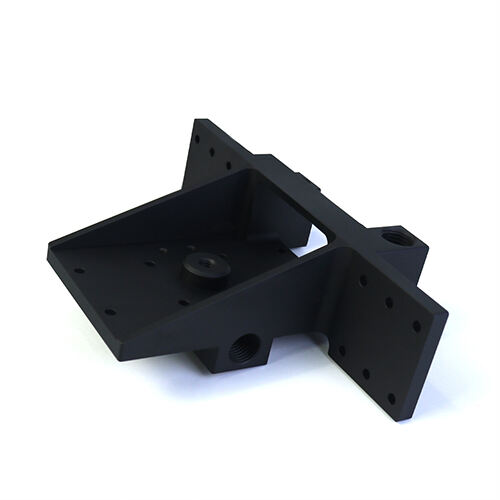Koji CNC stroj je najpogodniji za izradu komponenti visoke preciznosti za zrakoplovnu industriju?
Nepopustljivi zahtjevi aerokosmičke industrije za lakšim, jačim i pouzdanijim komponentama nameću izuzetne zahtjeve na proizvodnu opremu. S tolerancijama koje redovito premašuju ±0,025 mm i materijalima koji variraju od aluminijskih legura do visokotemperaturnih superlegura , odabir odgovarajuće CNC opreme postaje ključna strateška odluka. Dok napredujemo kroz 2025. godinu, proizvođači suočavaju se sa sve većim pritiskom da optimiziraju preciznost i produktivnost, istovremeno održavajući usklađenost s rigoroznim kvalitetnim standardima aerokosmičke industrije. Ova analiza sustavno uspoređuje vodeće CNC tehnologija kako bi identificirala optimalne primjene za različite kategorije aerokosmičkih komponenti , pružajući temeljene uvid u odluke o kapitalnim ulaganjima.

Metode istraživanja
1. Okvir evaluacije
Studija je koristila sveobuhvatnu metodologiju procjene:
• Testiranje dimenzionalne točnosti kroz više serija proizvodnje
• Mjerenje kvalitete površine pomoću kontaktne i bezkontaktne profilometrije
• Analiza brzine uklanjanja materijala za različite legure za zrakoplovnu industriju
• Praćenje vremena postavljanja i učinkovitosti prelaska na drugi zadatak
2.Oprema i materijali
Procjena je obuhvatila:
• Četiri vrste strojeva: 5-osna obradna središta, švajcarske tokarske strojeve, višenamjenske strojeve i precizne svrdla za kalupe
• Materijale za zrakoplovnu industriju: Titan 6Al-4V, Inconel 718, Aluminij 7075 i ugljične kompozite
• Standardne testne komponente: Konstrukcijski nosači, lopatice turbine, kućišta aktuatora i spojni elementi
• Mjerna oprema: CMM s rezolucijom od 0,001 mm, uređaji za mjerenje hrapavosti površine i optički uspoređivači
3.Protokol testiranja i reproducibilnost
Standardizirano testiranje osiguralo je dosljedno prikupljanje podataka:
• Svaki stroj proizveo je pet identičnih testnih komponenti od svakog materijala
• Rezni parametri pratili su preporuke proizvođača alata za zračne aplikacije
• Okolišni uvjeti održavani na 20±1°C s vlažnošću od 45-55%
• Svi alati, stezni pribor i postupci mjerenja dokumentirani su u dodatku
Rezultati i analiza
1. Točnost pozicioniranja i ponovljivost
Usporedba dimenzionalnih performansi među različitim tipovima strojeva
| Vrsta stroja | Točnost pozicioniranja (mm) | Volumetrijska točnost | Ponovljivost (mm) |
| 5-osni obradni centar | ±0.005 | 0.015 | ±0.0025 |
| Višenamjenska mašina | ±0.006 | 0.018 | ±0.003 |
| Švajcarski tokar | ±0.004 | N/A | ±0.002 |
| Precizni alatni svrdljar | ±0.003 | 0.008 | ±0.0015 |
Iako su jig borers pokazali izvrsnu apsolutnu točnost, njihova ograničena univerzalnost je ograničila primjenu na određene tipove komponenti. Pet-osi mašine pružaju najbolju kombinaciju točnosti i fleksibilnosti za složene aeroprostorne geometrije.
2. Kvaliteta površine i geometrijska sposobnost
Pet-osi obradni centri postigli su kvalitetu površine Ra 0,4 μm na profiliranim površinama, nadmašujući druge konfiguracije kod složenih 3D geometrija. Švajcarski tokari ističu se u proizvodnji komponenata malog promjera (3–20 mm) s kvalitetom površine Ra 0,2 μm, posebno za hidraulične i gorivne sustave.
3. Metrike efikasnosti proizvodnje
Višenamjenske mašine smanjile su ukupno vrijeme obrade za 25–40% kod složenih rotacijskih komponenata eliminiranjem sekundarnih operacija. Za strukturne komponente koje zahtijevaju složeno profiliranje, pet-osi mašine pokazale su 30% veće brzine skidanja materijala u odnosu na 3-osi konfiguracije.
Rasprava
1. Tumačenje tehničkih performansi
Superiorna performansa petoosnih obradnih centara proizlazi iz njihove sposobnosti održavanja optimalne orijentacije alata tijekom složenih putanja obrade. Ova mogućnost smanjuje otklanjanje alata, poboljšava uklanjanje strugotine i omogućuje kontinuirano rezanje — sve ključni faktori za materijale korištene u zrakoplovnoj industriji. Smanjene potrebe za podešavanjem složenih komponenti dodatno povećavaju točnost tako što se minimiziraju pogreške ponovnog pozicioniranja radnog komada.
2. Ograničenja i praktična ograničenja
Studija se fokusirala na standardne komponente zrakoplovne industrije; specijalizirane primjene mogu dati različite rezultate. Ekonomski faktori, uključujući početna ulaganja, troškove održavanja i zahtjeve za vještinama operatera, nisu uključeni u ovu tehničku evaluaciju. Dodatno, istraživanje je pretpostavilo odgovarajuće održavanje i kalibraciju strojeva sukladno specifikacijama proizvođača.
3. Smjernice za odabir za primjene u zrakoplovnoj industriji
Na temelju dobivenih rezultata, preporučuje se sljedeći okvir za odabir:
• Strukturni dijelovi s kompleksnim konturama: 5-osni obradni centri
• Mala, precizna rotacijska dijela: Švajcarski tokovi
• Kompleksni rotacijski dijelovi s funkcijama glodanja: Višenamjenski strojevi
• Visokoprecizni uzorci rupa i pribor za vođenje: Precizni doradi
Odabir stroja treba uzeti u obzir i specifične karakteristike materijala, pri čemu 5-osni strojevi pokazuju posebne prednosti kod teško obrađivih legura poput Inconela i titana.
Zaključak
Obradni centri s pet osi predstavljaju najuniverzalnije rješenje za većinu visoko preciznih komponenti u zrakoplovnoj industriji, postižući točnost pozicioniranja unutar ±0,005 mm uz obradu složenih geometrija i teško obrađivih materijala. Višenamjenski strojevi pružaju značajne prednosti u učinkovitosti za komponente koje zahtijevaju operacije i tokarenja i glodanja, dok švicarski tokarilice ostaju neprevaziđene za precizne dijelove malog promjera. Proizvođači bi odabir opreme trebali temeljiti na specifičnim karakteristikama komponenti, količinama proizvodnje i zahtjevima za materijalom, pri čemu tehnologija s pet osi čini osnovu za većinu modernih pogona za proizvodnju u zrakoplovnoj industriji. Buduća istraživanja trebala bi istražiti integraciju sposobnosti aditivne proizvodnje i naprednih sustava nadzora kako bi se dodatno poboljšala preciznost i učinkovitost.


